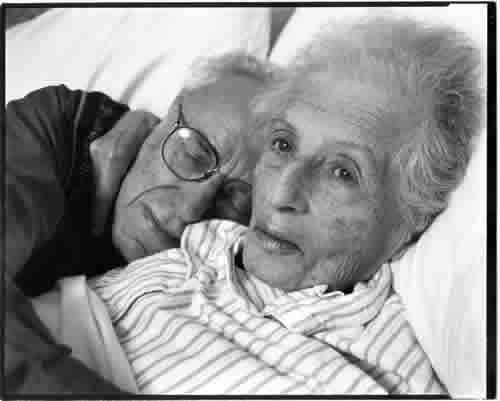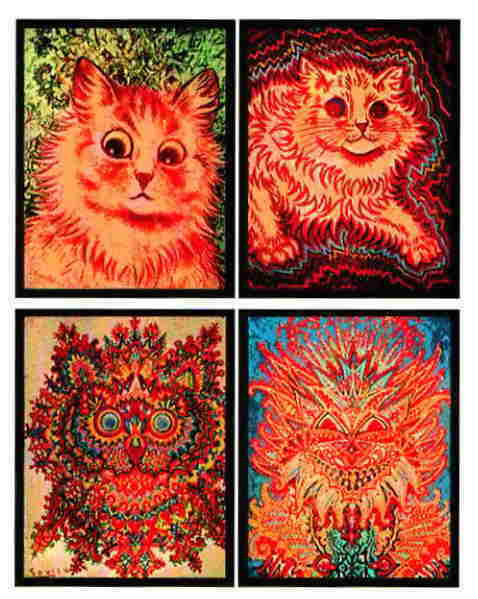Lesson 11: Psychiatric Disorders and Aging
Attention

Review the American Association of Suicidology "Elderly Suicide Fact Sheet"
Learning Outcomes
Upon completion of this lesson's material, students will be able to:
- Identify ways in which normal loss and clinical depression are different
- List ways in which Mental Health workers provide services for individuals who experience loss
- Research information that would be useful for a family to understand Post Traumatic Stress Disorder (PTSD)
- Evaluate personal views on dealing with symptomatology of Schizophrenia
Teaching
Depressive Disorders
The DSM-5 classifies Depressive Disorders as follows:
- Major Depressive Disorder
- Persistent Depressive Disorder (formally Dysthymia)
- Premenstrual Dysphoric Disorder
- Substance/Medication Induced Depressive Disorder
- Disruptive Mood Dysregulation Disorder
- Depressive Disorder due to another medical condition
- Other Specified Depressive Disorder
- Read about a brief description of each of the Depressive Disorders
Depression vs. Loss/Grief
As we age we experience more and more loss. We may feel loss of spouses, friends, etc who die. We may also feel loss and pain from opportunities that have passed us by, or regrets. Most people deal well with most loss with adequate social networks, supports, and coping mechanisms. If symptoms persist for 4-6 weeks, we may be looking at clinical depression.
Here are the signs to look for:
- Sleep disturbances
- Lack of interest or pleasure in almost all activities
- Inappropriate guilt / feelings of worthlessness / hopelessness
- Lack of energy
- Concentration difficulties and indecisiveness
- Lack of appetite
- Psychomotor agitation or retardation
- Suicidal ideation, plans, or attempts
However, even grief professionals disagree between what is normal and abnormal reaction to loss.
Read Depression vs. Complicated Grief and The Difference Between Grief and Depression, The DSM V
There is a new catergory for futher review in the DSM-5 called Persistent Complex Bereavement Disorder. Read about it in the link below:
Persistent-Complex-Bereavement-Disorder-DSM-5
Post Traumatic Stress Disorder (PTSD)
The first identification of Post Traumatic Stress Disorder (PTSD) came from the military...although they denied that it was as disabling as it turned out to be. It has been known by other names, such as "Stress Syndrome" and "Shell Shock" and "Battle Fatigue". The Wikipedia source on this is actually quite interesting!
When working in the mental health field we will come across a lot of people with some sort of Anxiety Disorders and Trauma- and Stressor-Related Disorders. Keep in mind that PTSD is considered an Trauma- and Stressor-Disorder, not an Anxiety Disorder. The symptoms of Generalized Anxiety Disorder (GAD) can appear very similar to the symptoms that we see in clients with PTSD. It is said that the experience of PTSD, when triggered, is to re-experience the emotions that the person experienced during the trauma. So, a person with PTSD related to being raped will have the same emotional experiences when triggered. They will have the same emotions as if they are currently being raped! As you can likely tell, this can be highly disruptive.
Here is a webpage about Aging Veterans and PTSD
Complex PTSD
Another diagnosis that we may come across fairly often in our work is Complex PTSD. This type of PTSD is often associated with long-term, ritualistic abuse and neglect. Click HERE to view a great summary of the disorder from the Veteran's Administration (VA). Some authors contend the Borderline Personality is better understood as Complex Post Traumatic Stress Disorder.
Treatment
PTSD is very treatable using a combination of behavioral therapy and pharmacological treatments (psychotropic medications that affect a person's brain chemistry). Medication can often take the "edge off" the sense of anxiety, fear and dread, while therapy focuses on changing behavioral problems associated with the feelings PTSD can illicit in individuals (i.e. what to do when the feelings start to get out of control). Often the anxiety, fear and dread that someone feels is perpetuated by poor habits of thinking that exacerbate the emotional reactions. Feelings of impending doom and powerlessness predominate the individual's thinking and they can become anxious about THAT as well!
Working with Individuals with Anxiety
The key aspect of working with individuals with an Anxiety Disorder is to accept that the anxiety is truly disabling. It is not enough for us to say to someone to "not worry about it". The thoughts they have are invasive and persistent, so the issue is that they can't see to stop thinking about it no matter how hard they try.
Schizophrenia

I found this image on www.schizophrenia.org.
The artist is Louis Wain, who was fascinated by cats, who painted these over a course of time as he developed Schizophrenia.
Visit this website for some interesting articles and insight into Schizophrenia.
Schizophrenia is a serious mental health disorder that affects how a person thinks, feels and acts. Someone with schizophrenia may have difficulty distinguishing between what is real and what is imaginary; may be unresponsive or withdrawn; and may have difficulty expressing normal emotions in social situations. Contrary to public perception, schizophrenia is not split personality or multiple personality. The vast majority of people with schizophrenia are not violent and do not pose a danger to others. Schizophrenia is not caused by childhood experiences, poor parenting or lack of willpower, nor are the symptoms identical for each person. The cause of schizophrenia is still unclear. Some theories about the cause of this disease include: genetics (heredity), biology (the imbalance in the brain’s chemistry); and/or possible viral infections and immune disorders.
Scientists recognize that the disorder tends to run in families and that a person inherits a tendency to develop the disease (genetics, hereditary causes). Schizophrenia may also be triggered by environmental events, such as viral infections or highly stressful situations or a combination of both. Similar to some other genetically-related illnesses, schizophrenia appears when the body undergoes hormonal and physical changes, like those that occur during puberty in the teen and young adult years. The symptoms generally appear during the teenage or young adult years.
Genetics help to determine how the brain uses certain chemicals. People with schizophrenia have a chemical imbalance of brain chemicals (serotonin and dopamine) which are neurotransmitters. These neurotransmitters allow nerve cells in the brain to send messages to each other. The imbalance of these chemicals affects the way a person’s brain reacts to stimuli--which explains why a person with schizophrenia may be overwhelmed by sensory information (loud music or bright lights) which other people can easily handle. This problem in processing different sounds, sights, smells and tastes can also lead to hallucinations or delusions. (This section on schizophrenia from http://www.mentalhealthamerica.net/conditions/schizophrenia if you want to read more about it).
Watch video Mind Maters-Mental Health for older people (20:04 min)
Mental health issues affect older individuals in all different ways, as the video explains. Add to this when an individual has a mental illness, such as schizophrenia, generalized anxiety disorder or PTSD. About 25% of older people with Schizophrenia developed it later in life, the other 75% developed it during adolescence or early adulthood. Research on late-onset Schizophrenia is very limited.
Video information Late Onset Schizophrenia (1:42 min)
Read article Many faces of psychosis in older adults (3 pages)
Late-onset Schizophrenia can be quite disturbing and frightening to individuals and their families. Others who have had the symptoms since they were young are more familiar with some of the bizarre qualities of the disorder. As with our discussion on Dementia and Alzheimer's, our approach to working with individuals with Schizophrenia is with empathy and care. Symptoms, which can include delusions and hallucinations are very real to these individuals, and they are not likely "doing it for attention".
Although medical treatments for Schizophrenia can be very effective, there is a tendency for individuals to refuse medicine due to side effects (which can be very powerful) and a lack of insight into the illness itself. Relapses are often severe, very disruptive, and reduce quality of life. You can expect that you may have to deal with individuals who, after a long period of ups and downs with Schizophrenia, have finally "burned their last bridge" with family and other natural supports, and they are being referred to you for assistance. Case Management is a critical service for individuals with Schizophrenia.
The focus of treatment is often on day-to-day problem solving and simply maintaining health outside of the hospital in-between relapse. If you look at the list of "Goals of Treatment" (on p. 141) you can see the pragmatic goals of simple problem solving, housing, substance use, and keeping them "out of trouble". Individuals with long-term Schizophrenia are more likely to have "learned their way in the world" and have learned to adapt and deal with their disorder, the reduced life script, and the long-term outcomes of having Schizophrenia. Persons with late-onset of Schizophrenia are less equipped to deal with the severe disabling effect of this disorder.
All of the mental health disorders we see in younger populations we can also see in older adults. Here are some additional mental health disorders you night encounter when working with older adults but this is certainly not an all inclusive list.
- Eating Disorders - Read articles: Elder Eating Disorders - Surprising New Challenge AND Older Clients and Eating Disorders
- Somatoform Disorders
Somatoform disorders are presentations where physical symptoms worry a patient, there is no organic pathology to explain them, but reassurance fails. They represent a murky borderland between medicine and psychiatry and understanding has not been helped by the plethora of terms used in this area. A typical scenario would be a 68-year-old woman who was recently widowed complaining to a general practitioner of headache, trouble sleeping, tiredness and muscle pain. Blood tests are negative but the patient says “there must be something wrong”. Faced with uncertainty, clinicians may easily fall back on a fruitless path of investigations and referrals. There is plenty of knowledge regarding somatoform disorders among younger people (who have fewer physical illnesses), but much less regarding older people. (Sheehan, B., 2006 http://www.futuremedicine.com/doi/abs/10.2217/1745509X.2.6.1035?journalCode=ahe)
Read website: Undifferentiated Somatoform Disorder
- Personality Disorders - DSM 5 Personality Disorder
Read the following brief web article: Helping an Older Loved One with a Personality Disorder
- Sleep Disorders
View the following presentation by The National Sleep Foundation: Sleep and Aging Well
- Sexual Function and Dysfunction
Read the following online article: Sexual Dysfunction in the Elderly: Age or Disease?
Assessment
Lesson 11 Quiz
- Pick one of the mental health disorders described in this lesson. Indicate the symptoms of the disorder and two treatment options for that disorder. Include links for any online resources that you used. Do not cut and paste but instead summarize the information in your own words.
- Explain the difference between grief and depression. Include links to resources you used. You can use additional resources besides those included in this lesson.
Lesson 11 Assignment
For this assignment you will select a mental health disorder that presents itself in older adults and create a brochure (Part 1) with a companion video with voice (Part 2) over to educate family members and consumers. You will need to do some background research from reliable sources on the web (not Wikipedia for example). To create the brochure and video you need to do the following:
- Select a mental health disorder that presents itself in older adults
- Research how the disorder affects older adults
- List the primary symptoms to look for
- List at least two effective treatments
- Include one or two places for a person to go for more info (a website, a phone number, etc.). These should be the same places you went for information.
- Use visually appealing fonts and formating in document and video
- Include images that complement the theme in your document and video
Part 1: Print Brochure
Using the 7 items above put together a two-page brochure (front and back of one 8 1/2 x 11 page, preferable trifold) that contains information that you could help a family member or person with the disorder/diagnosis you selected. You can choose any word processing format you want to use to create your document. Creativity counts on this one so make this colorful, artistic, and attractive to look at. Once completed you will submit this to the instructor through the Blackboard Assignment drop box.
Part 2: AdobeVoice Presentation
Using the research on your topic and the materials in your brochure create an AdobeVoice Presentation. This presentation needs to include text, images and a voice over (using your voice talking) to share the information you learned. It should be created to be understood by family members and clients and should elaborate on the information in your brochure since you will have the ability to talk as well as share images and text. Your verbal portions should be more than just reading the text on your slides. Both documents should complement each other.
NOTE: This "Assignment" actually appears as a Discussion in Blackboard. When you have completed your AdobeVoice Presentation, copy the URL (hyperlink) into a discussion post in Blackboard. You are expected to view and comment on each other's presentations. The grade, however, will not be a function of the posting, but of the quality of the Presentation alone. I'm looking for creativity and clarity of information. Your instructor, MHT faculty and KVCC Library staff can help you with AdobeVoice if you have questions.
For this assignment you are going to create a visual presentation with a voice over recording using AdobeVoice. This app is very easy to use on the iPad and free. Let your instructor know if you need assistance using this application. When the project is completed the application gives you the option to share via email. Select that option an and email yourself the URL/hyperlink. You will then use this URL/hyperlink to share your project with your Instructor and classmates. You can then copy that URL into a discussion board thread. Adobe Spark Video https://itunes.apple.com/us/app/adobe-spark-video/id852555131?mt=8 |

